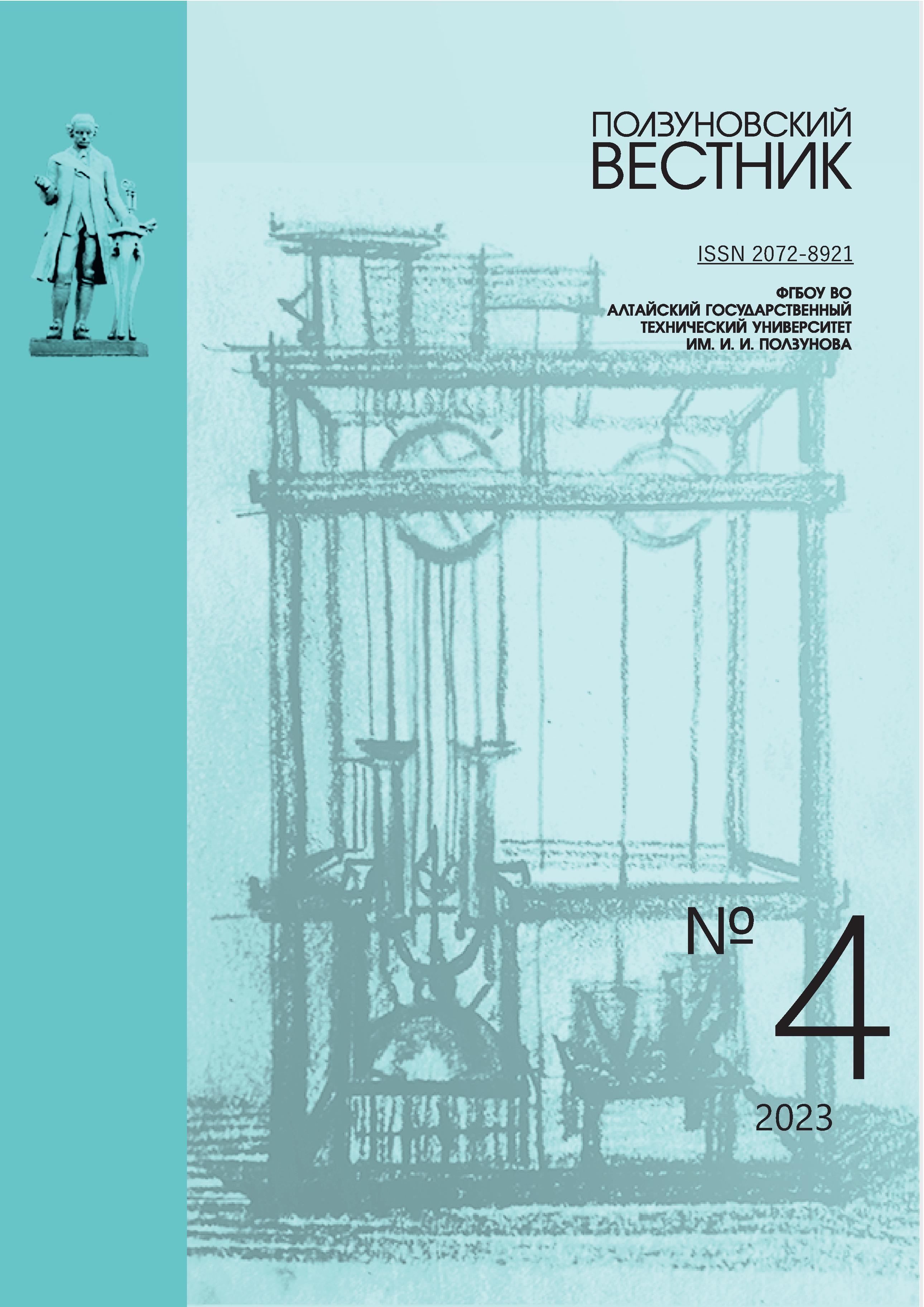FRACTURE OF LAMELLAR PEARLITE IN THE TRED SURFACE OF RAILS DURING LONG-TERM OPERATION
YPKKNK
DOI:
https://doi.org/10.25712/ASTU.2072-8921.2023.04.024Keywords:
destruction of cementite, surface, rails, extinction contours, dislocations, exploitation, electron micros-copy.Abstract
Using the methods of transmission electron diffraction microscopy, the structure, phase composition, dislocation substructure in surface layers up to 2 mm deep from the surface of the fillet of differentially hardened special-purpose rails made of E90KhAF steel were analyzed after a missed tonnage of 187 million gross tons. The structure of rail steel is represented mainly by grains of lamellar perlite, in the ferrite of which a dislocation substructure is observed, formed by randomly distributed dislocations and networks. The formation of bending contours of extinction has been established and the sources of curvature-torsion of the crystal lattice have been identified. The average transverse dimensions of the extinction contours reach their minimum values at a depth of 2 mm. It is shown that the scalar density of dislocations of the studied steel increases as it approaches the surface of the rail fillet, reaching a maximum value at a distance of 2 mm from the surface. The mechanisms of destruction of cementite plates (cutting by moving dislocations and dissolution in place) and the precipitation of nanosized particles of the carbide phase are considered.
References
Structure and properties of lengthy rails after extreme long-term operation / A.A. Yuriev [et al.] Millersville, PA, USA: Materials Research Forum LLC, 2021.
Shear-induced α → γ transformation in nanoscale Fe–C composite / Yu. Ivanisenko [et al.] // Acta Materialia. 2006. V. 54. P. 1659–1669. https://doi.org/10.1016/j.actamat.2005.11.034.
The mechanical properties of the nano-crystalline layer on the surface of railway tracks / W. Lojkowski [et al.] // Materials Science and Engineering: A. 2003. V. 303. № 1–2. P. 209–215. https://doi.org/10.1016/S0921-5093(00)01948-1.
Nanostructure formation on the surface of railway tracks / W. Lojkowski [et al.] // Materials Science and Engineering: A. 2001. V. 303. P. 197–208.
Ivanisenko Yu., Fecht H.J. Microstructure modification in the surface layers of railway rails and wheels: effect of high strain rate deformation // Steel Tech. 2008. V. 3. № 1. P. 19–23.
Takahashi J., Kawakami K., Ueda M. Atom probe tomography analysis of the white etching layer in a railtrack surface // Acta Materialia. 2010. V. 58. P. 3602–3612. https://doi.org/10.1016/j.actamat.2010.02.030.
Деформационное преобразование структуры и фазового состава поверхности рельсов при сверхдлительной эксплуатации / В.Е. Громов [и др.] // Деформация и разрушение материалов. 2022. № 1. С. 35–39. DOI: 10.31044/1814-4632-2022-1-35-39.
Gavrilyuk V.G. Decomposition of cementite in pearlitic steel due to plastic deformation // Materials Science and Engineering: A. 2003. V. 345. P. 81–89. https://doi.org/10.1016/S0921-5093(02)00358-1.
Newcomb S.B., Stobbs W.M. A transmission electron microscopy study of the white-etching layer on a railhead // Materials Science and Engineering. 1984. V. 66. P. 195–204.
Ishida M. Rolling contact fatigue (RCF) defects of rails in Japanese railways and its mitigation strategies // Electronic Journal of Structural Engineering. 2013. V. 13. P. 67–74. https://doi.org/ 10.56748/ejse.131621.
Steenbergen M., Dollevoet R. On the mechanism of squat formation on train rails: Part I. Origination // International Journal of Fatigue. 2013. V. 47. P. 361–372. https://doi.org/10.1016/j.ijfatigue. 2012.04.023.
Carroll R.J., Beynon J.H. Rolling contact fatigue of white layer. Crock morphologe // Wear. 2007. V. 262. P. 1253–1266. doi : 10.1016/j.wear. 2007.01.003.
Градиенты структуры, фазового состава и дислокационной субструктуры рельсов при сверхдлительной эксплуатации / Р.В. Кузнецов [и др.] // Известия Алтайского государственного университета. 2022. № 1. С. 44–50. https://doi.org/ 10.14258/izvasu(2022)1-06.
Формирование тонкой структуры перлит-ной стали при сверхдлительной пластической деформации / К.В. Григорович [и др.] // Доклады Российской академии наук. Физика, технические науки. 2022. Т. 503. С. 8–12. DOI : 10.31857/S2686740022020079.
Egerton F.R. Physical Principles of Electron Microscopy. Basel: Springer International Publishing, 2016.
Kumar C.S.S.R. Transmission Electron Microscopy. Characterization of Nanomaterials. New York: Springer, 2014.
Carter C.B., Williams D.B. Transmission Electron Microscopy. Berlin: Springer International Publishing, 2016.
Конева Н.А., Козлов Э.В. Дислокационная структура и физические механизмы упрочнения металлических материалов // Перспективные материалы. Структура и методы исследования : учеб. пособие / Под ред. Д.Л. Меерсона. Тула : ТГУ. М. : МИСиС. 2006. С. 267–320.
Физика и механика волочения и объемной штамповки / В.Е. Громов [и др.]. М., Недра, 1997.
Tsellermaer V.Y. Substructural and phase transformations during intense plastic deformation of metals // Steel in Translation. 1999. V. 29. № 12. P. 75–81.
Эволюция тонкой структуры и свойств металла рельсов при длительной эксплуатации / В.Е. Панин [и др.] // Физическая мезомеханика. 2020. Т. 23. № 5. С. 85–94. DOI : 10.24411/1683-805X-2020-15007.
Панин В.Е., Егорушкин В.Е., Панин А.В. Нелинейные волновые процессы в деформируемом твердом теле как многоуровневой иерархически организованной системе // УФН. 2012. Т. 182. № 12. С. 1351–1357. https://doi.org/ 10.3367/UFNr.0182.201212i.1351.
Роль кривизны решетки в деградации структуры поверхностного слоя металла рельсов при длительной эксплуатации / В.Е. Панин [и др.] // Доклады РАН. Физика, технические науки. 2020. Т. 494. С. 68–71. DOI : 10.31857/S2686740020050144.
Рыбин В.В. Большие пластические деформации и разрушение металлов. М. : Металлургия, 1986.
Downloads
Published
How to Cite
Issue
Section
License
Copyright (c) 2023 Yurii F. Ivanov, Victor E. Gromov, Michael A. Porfiriev, Roman E. Kryukov, Vitaly V. Shlyarov

This work is licensed under a Creative Commons Attribution 4.0 International License.















 .
. This work is licensed under a
This work is licensed under a 
